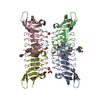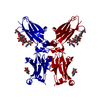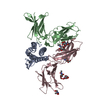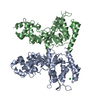[English] 日本語
 Yorodumi
Yorodumi- PDB-4oju: Crystal structure of a leucine-rich repeat protein (BACCAP_00569)... -
+ Open data
Open data
- Basic information
Basic information
| Entry | Database: PDB / ID: 4oju | ||||||
|---|---|---|---|---|---|---|---|
| Title | Crystal structure of a leucine-rich repeat protein (BACCAP_00569) from Bacteroides capillosus ATCC 29799 at 2.00 A resolution | ||||||
 Components Components | hypothetical leucine rich repeat protein | ||||||
 Keywords Keywords |  STRUCTURAL GENOMICS / UNKNOWN FUNCTION / STRUCTURAL GENOMICS / UNKNOWN FUNCTION /  Leucine rich repeats / PF13306 family protein / Leucine rich repeats / PF13306 family protein /  putative protein binding / Joint Center for Structural Genomics / JCSG / putative protein binding / Joint Center for Structural Genomics / JCSG /  Protein Structure Initiative / PSI-BIOLOGY Protein Structure Initiative / PSI-BIOLOGY | ||||||
| Function / homology |  Function and homology information Function and homology informationBspA type Leucine rich repeat region / S-layer homology domain / BspA type Leucine rich repeat region (6 copies) / S-layer homology domain / S-layer homology (SLH) domain profile. /  Leucine-rich repeat, LRR (right-handed beta-alpha superhelix) / Leucine-rich repeat, LRR (right-handed beta-alpha superhelix) /  Ribonuclease Inhibitor / Alpha-Beta Horseshoe / Leucine-rich repeat domain superfamily / Immunoglobulin-like fold / Alpha Beta Ribonuclease Inhibitor / Alpha-Beta Horseshoe / Leucine-rich repeat domain superfamily / Immunoglobulin-like fold / Alpha BetaSimilarity search - Domain/homology | ||||||
| Biological species |  Pseudoflavonifractor capillosus (bacteria) Pseudoflavonifractor capillosus (bacteria) | ||||||
| Method |  X-RAY DIFFRACTION / X-RAY DIFFRACTION /  SYNCHROTRON / SYNCHROTRON /  SAD / Resolution: 2 Å SAD / Resolution: 2 Å | ||||||
 Authors Authors | Joint Center for Structural Genomics (JCSG) | ||||||
 Citation Citation |  Journal: To be published Journal: To be publishedTitle: Crystal structure of a hypothetical leucine rich repeat protein (BACCAP_00569) from Bacteroides capillosus ATCC 29799 at 2.00 A resolution Authors: Joint Center for Structural Genomics (JCSG) | ||||||
| History |
|
- Structure visualization
Structure visualization
| Structure viewer | Molecule:  Molmil Molmil Jmol/JSmol Jmol/JSmol |
|---|
- Downloads & links
Downloads & links
- Download
Download
| PDBx/mmCIF format |  4oju.cif.gz 4oju.cif.gz | 252.9 KB | Display |  PDBx/mmCIF format PDBx/mmCIF format |
|---|---|---|---|---|
| PDB format |  pdb4oju.ent.gz pdb4oju.ent.gz | 209.3 KB | Display |  PDB format PDB format |
| PDBx/mmJSON format |  4oju.json.gz 4oju.json.gz | Tree view |  PDBx/mmJSON format PDBx/mmJSON format | |
| Others |  Other downloads Other downloads |
-Validation report
| Arichive directory |  https://data.pdbj.org/pub/pdb/validation_reports/oj/4oju https://data.pdbj.org/pub/pdb/validation_reports/oj/4oju ftp://data.pdbj.org/pub/pdb/validation_reports/oj/4oju ftp://data.pdbj.org/pub/pdb/validation_reports/oj/4oju | HTTPS FTP |
|---|
-Related structure data
| Similar structure data | |
|---|---|
| Other databases |
- Links
Links
- Assembly
Assembly
| Deposited unit | 
| ||||||||
|---|---|---|---|---|---|---|---|---|---|
| 1 |
| ||||||||
| Unit cell |
|
- Components
Components
| #1: Protein | Mass: 16215.463 Da / Num. of mol.: 4 Source method: isolated from a genetically manipulated source Source: (gene. exp.)  Pseudoflavonifractor capillosus (bacteria) Pseudoflavonifractor capillosus (bacteria)Strain: ATCC 29799 / Gene: BACCAP_00569, ZP_02034978.1 / Plasmid: SpeedET / Production host:   Escherichia Coli (E. coli) / Strain (production host): PB1 / References: UniProt: A6NQU6 Escherichia Coli (E. coli) / Strain (production host): PB1 / References: UniProt: A6NQU6#2: Chemical | ChemComp-EDO /  Ethylene glycol Ethylene glycol#3: Chemical | #4: Water | ChemComp-HOH / |  Water WaterSequence details | THE CONSTRUCT WAS EXPRESSED WITH A PURIFICATION TAG MGSDKIHHHHHHENLYFQG. THE TAG WAS REMOVED WITH ...THE CONSTRUCT WAS EXPRESSED WITH A PURIFICATI | |
|---|
-Experimental details
-Experiment
| Experiment | Method:  X-RAY DIFFRACTION / Number of used crystals: 1 X-RAY DIFFRACTION / Number of used crystals: 1 |
|---|
- Sample preparation
Sample preparation
| Crystal | Density Matthews: 2.6 Å3/Da / Density % sol: 52.68 % |
|---|---|
Crystal grow | Temperature: 293 K / Method: vapor diffusion, sitting drop / pH: 8.5 Details: 0.2M magnesium chloride, 30.00% polyethylene glycol 4000, 0.1M tris hydrochloride pH 8.5, NANODROP, VAPOR DIFFUSION, SITTING DROP, temperature 293K |
-Data collection
| Diffraction | Mean temperature: 100 K | |||||||||||||||||||||||||||||||||||||||||||||||||||||||||||||||||||||||||||||
|---|---|---|---|---|---|---|---|---|---|---|---|---|---|---|---|---|---|---|---|---|---|---|---|---|---|---|---|---|---|---|---|---|---|---|---|---|---|---|---|---|---|---|---|---|---|---|---|---|---|---|---|---|---|---|---|---|---|---|---|---|---|---|---|---|---|---|---|---|---|---|---|---|---|---|---|---|---|---|
| Diffraction source | Source:  SYNCHROTRON / Site: SYNCHROTRON / Site:  ALS ALS  / Beamline: 8.2.2 / Wavelength: 0.979169 / Beamline: 8.2.2 / Wavelength: 0.979169 | |||||||||||||||||||||||||||||||||||||||||||||||||||||||||||||||||||||||||||||
| Detector | Type: ADSC QUANTUM 315 / Detector: CCD / Date: Oct 17, 2012 / Details: KOHZU: Double Crystal Si(111) | |||||||||||||||||||||||||||||||||||||||||||||||||||||||||||||||||||||||||||||
| Radiation | Monochromator: Double Crystal Si(111) / Protocol: SAD / Monochromatic (M) / Laue (L): M / Scattering type: x-ray | |||||||||||||||||||||||||||||||||||||||||||||||||||||||||||||||||||||||||||||
| Radiation wavelength | Wavelength : 0.979169 Å / Relative weight: 1 : 0.979169 Å / Relative weight: 1 | |||||||||||||||||||||||||||||||||||||||||||||||||||||||||||||||||||||||||||||
| Reflection | Resolution: 2→29.42 Å / Num. obs: 46541 / % possible obs: 99.9 % / Observed criterion σ(I): -3 / Biso Wilson estimate: 25.239 Å2 / Rmerge(I) obs: 0.103 / Net I/σ(I): 15.19 | |||||||||||||||||||||||||||||||||||||||||||||||||||||||||||||||||||||||||||||
| Reflection shell | Diffraction-ID: 1
|
-Phasing
Phasing | Method:  SAD SAD |
|---|
- Processing
Processing
| Software |
| |||||||||||||||||||||||||||||||||||||||||||||||||||||||||||||||||||||||||||||||||||||||||||||||||||||||||||||||||||||||||||||
|---|---|---|---|---|---|---|---|---|---|---|---|---|---|---|---|---|---|---|---|---|---|---|---|---|---|---|---|---|---|---|---|---|---|---|---|---|---|---|---|---|---|---|---|---|---|---|---|---|---|---|---|---|---|---|---|---|---|---|---|---|---|---|---|---|---|---|---|---|---|---|---|---|---|---|---|---|---|---|---|---|---|---|---|---|---|---|---|---|---|---|---|---|---|---|---|---|---|---|---|---|---|---|---|---|---|---|---|---|---|---|---|---|---|---|---|---|---|---|---|---|---|---|---|---|---|---|
| Refinement | Method to determine structure : :  SAD / Resolution: 2→29.42 Å / Cor.coef. Fo:Fc: 0.9532 / Cor.coef. Fo:Fc free: 0.9478 / Occupancy max: 1 / Occupancy min: 0.25 / Cross valid method: THROUGHOUT / σ(F): 0 SAD / Resolution: 2→29.42 Å / Cor.coef. Fo:Fc: 0.9532 / Cor.coef. Fo:Fc free: 0.9478 / Occupancy max: 1 / Occupancy min: 0.25 / Cross valid method: THROUGHOUT / σ(F): 0 Details: 1. ATOM RECORD CONTAINS SUM OF TLS AND RESIDUAL B FACTORS. ANISOU RECORD CONTAINS SUM OF TLS AND RESIDUAL U FACTORS. 2. A MET-INHIBITION PROTOCOL WAS USED FOR SELENOMETHIONINE INCORPORATION ...Details: 1. ATOM RECORD CONTAINS SUM OF TLS AND RESIDUAL B FACTORS. ANISOU RECORD CONTAINS SUM OF TLS AND RESIDUAL U FACTORS. 2. A MET-INHIBITION PROTOCOL WAS USED FOR SELENOMETHIONINE INCORPORATION DURING PROTEIN EXPRESSION. THE OCCUPANCY OF THE SE ATOMS IN THE MSE RESIDUES WAS REDUCED TO 0.75 TO ACCOUNT FOR THE REDUCED SCATTERING POWER DUE TO PARTIAL S-MET INCORPORATION. 3. 1,2 ETHANEDIOL (EDO) AND MG-ION FROM THE CRYOPROTECTANT AND FROM THE CRYSTALLIZATION CONDITION HAVE BEEN MODELED IN THE SOLVENT STRUCTURE. 4. SOME N- and C-TERMINAL RESIDUES ARE DISORDERED. 5. THE MAD PHASES WERE USED AS RESTRAINTS DURING REFINEMENT. 6. NCS RESTRAINTS WERE APPLIED USING BUSTER'S LSSR RESTRAINT REPRESENTATION (-AUTONCS).
| |||||||||||||||||||||||||||||||||||||||||||||||||||||||||||||||||||||||||||||||||||||||||||||||||||||||||||||||||||||||||||||
| Displacement parameters | Biso max: 129.79 Å2 / Biso mean: 31.5009 Å2 / Biso min: 5.81 Å2
| |||||||||||||||||||||||||||||||||||||||||||||||||||||||||||||||||||||||||||||||||||||||||||||||||||||||||||||||||||||||||||||
| Refine analyze | Luzzati coordinate error obs: 0.205 Å | |||||||||||||||||||||||||||||||||||||||||||||||||||||||||||||||||||||||||||||||||||||||||||||||||||||||||||||||||||||||||||||
| Refinement step | Cycle: LAST / Resolution: 2→29.42 Å
| |||||||||||||||||||||||||||||||||||||||||||||||||||||||||||||||||||||||||||||||||||||||||||||||||||||||||||||||||||||||||||||
| Refine LS restraints |
| |||||||||||||||||||||||||||||||||||||||||||||||||||||||||||||||||||||||||||||||||||||||||||||||||||||||||||||||||||||||||||||
| LS refinement shell | Resolution: 2→2.05 Å / Total num. of bins used: 20
| |||||||||||||||||||||||||||||||||||||||||||||||||||||||||||||||||||||||||||||||||||||||||||||||||||||||||||||||||||||||||||||
| Refinement TLS params. | Method: refined / Refine-ID: X-RAY DIFFRACTION
| |||||||||||||||||||||||||||||||||||||||||||||||||||||||||||||||||||||||||||||||||||||||||||||||||||||||||||||||||||||||||||||
| Refinement TLS group |
|
 Movie
Movie Controller
Controller










 PDBj
PDBj




